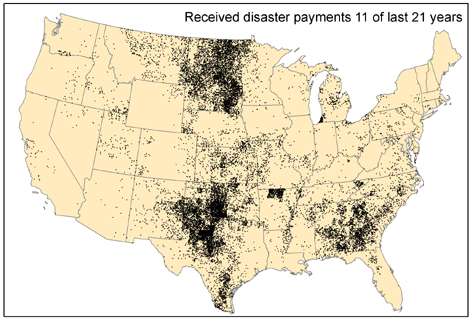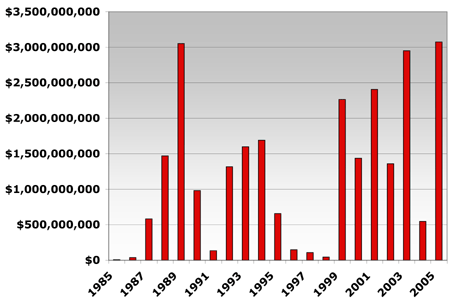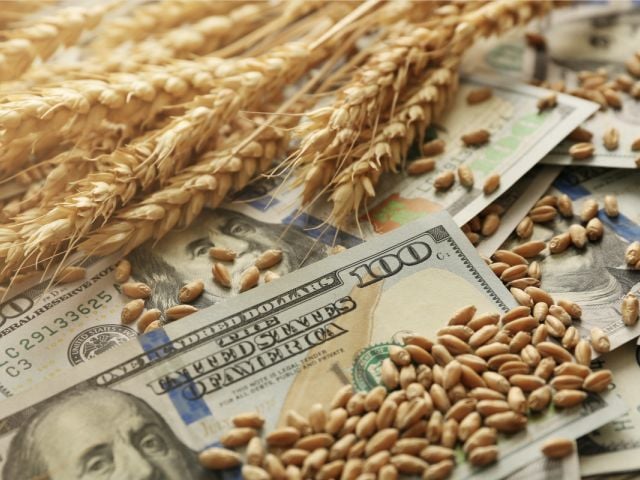
Pressure is building in Congress for pre-election enactment of the most expensive emergency agricultural disaster aid bill in history.
The $6.55 billion omnibus measure (The Emergency Farm Relief Act of 2006, S. 3855)provides hundreds of millions of dollars for projects and programs completely unrelated to crop and livestock losses associated with drought and hurricanes. Among these extras, there is a subsidy bonus of $1.5 billion in "energy assistance" directed exclusively to subsidized crop farmers who collected over $22 billion from taxpayers in 2005 and will receive billions more this year.
Proponents of the bill describe the crop and livestock impacts of recent dry weather in the Great Plains as unusually severe, likening it to the conditions during Dust Bowl of the 1930s. But there is nothing unusual about this year's clamor for emergency agricultural disaster aid, millions of dollars of which will go to the very same farmers and ranchers who have collected it every other year, or more frequently, for decades. (Figure 1).
Figure 1. Chronic recipients of disaster aid are concentrated in the Great Plains.

1 dot = 1 recipient
Source: Environmental Working Group. Compiled from USDA data.
Over the past 21 years, taxpayers have provided nearly $26 billion in emergency agricultural disaster aid to more than two million farm and ranch operations, a new EWG farm-by-farm computer investigation of USDA records has found. USDA sent out disaster aid checks every year for the past two decades, with payouts exceeding one billion dollars in 11 of the 21 years studied (Figure 2).
Figure 2. Disaster spending from 1985-2005: $25.8 billion to 2 million recipients

Source: Environmental Working Group. Compiled from USDA data.
The $26 billion total does not include billions more paid through the heavily subsidized federal crop insurance program or the "emergency economic assistance" that roughly doubled subsidies for commodity crop farmers between 1998 and 2002.
The pending $6.55 billion Emergency Farm Relief Act would thus amount to a 25 percent addition to the total amount of agricultural disaster aid taxpayers have provided farms and ranches over more than two decades.
Agricultural disaster aid should be thought of as serving two distinct groups of farmers and ranchers. The overwhelming majority rarely receives disaster checks from taxpayers, and the amount of assistance is modest. The second group, the primary source of the political pressure for disaster aid every year, is a small minority of the recipients, but they are chronically dependent on disaster aid and over two decades have collected it one year out of every two or three, if not more frequently.
Our review shows that vast majority of the 2 million farmers and ranchers who have received disaster aid over the past 21 years have received it infrequently, with 75 percent collecting payments three years or less out of 21 (Table 1).
Table 1. Disaster aid dependency
| Number of years receiving disaster payments |
Number recipients receiving disaster payments |
Average disaster payment, 1985-2005 |
Total disaster payments, 1985-2005 |
Percent of recipients |
|---|---|---|---|---|
| 1 | 848,431 | $3,000 | $2,545,293,000 | 41.7% |
| 2 | 431,431 | $6,605 | $2,849,688,041 | 21.2% |
| 3 | 260,066 | $11,493 | $2,989,024,360 | 12.8% |
| 4 | 171,641 | $17,253 | $2,961,320,457 | 8.4% |
| 5 | 109,098 | $25,445 | $2,776,025,885 | 5.4% |
| 6 | 72,821 | $33,190 | $2,416,928,990 | 3.6% |
| 7 | 48,784 | $43,286 | $2,111,661,785 | 2.4% |
| 8 | 33,990 | $54,326 | $1,846,524,425 | 1.7% |
| 9 | 23,200 | $68,560 | $1,590,583,184 | 1.1% |
| 10 | 15,227 | $84,786 | $1,291,035,813 | 0.75% |
| 11 | 9,752 | $99,900 | $974,220,607 | 0.48% |
| 12 | 5,791 | $115,827 | $670,755,547 | 0.28% |
| 13 | 3,083 | $136,120 | $419,657,559 | 0.15% |
| 14 | 1,509 | $155,086 | $234,024,216 | 0.07% |
| 15 | 680 | $178,627 | $121,466,258 | 0.03% |
| 16 | 218 | $224,169 | $48,868,809 | 0.01% |
| 17 | 45 | $271,196 | $12,203,831 | < 0.01% |
| 18 | 6 | $516,342 | $3,098,051 | < 0.01% |
| 19 | 1 | $229,547 | $229,547 | < 0.01% |
| 11 or more | 21,081 | $117,834 | $2,484,524,425 | 1.0% |
| 14 or more | 2,459 | $170,757 | $419,890,712 | 0.12% |
| Total | 2,035,774 | $25,862,610,364 |
Source: Environmental Working Group. Compiled from USDA data.
But a minority of the recipients are chronic beneficiaries of disaster funds, with some 21,000 of them (about 1 percent of recipients) collecting disaster aid more than 11 years out of 21, amounting to $2.5 billion, or almost 10 percent of the total payments (Table 1). These chronic beneficiaries, on average, collected payments for 12 of 21 years and received an average of $118,000 a piece in aid.
We found 2,459 recipients, (0.12 percent of recipients) who collected $420 million, or 1.6 percent of the so-called "emergency" disaster payments 14 years or more out the past 21 years, or two thirds of the time.
While every state received at least some disaster payments over the period, five states--Texas, South Dakota, North Dakota, Oklahoma and Georgia--account for 67 percent of the chronic beneficiaries who collected disaster funds every other year, or more often, for two decades (Table 2). The heavy concentration of chronic recipients in Texas, South Dakota, North Dakota and Oklahoma simply reflects the difficulty of raising crops and to a lesser degree livestock in a region of perennially low rainfall. It also raises the question of whether taxpayers ought to be obligated to provide a continuous stream of aid when "disaster emergency" is the rule and not the exception.
Table 2. Top States for chronic disaster aid recipients
| State | Number of recipients receiving disaster payments in 11 or more years |
Total Disaster Payments 1985-2005 |
Percent of Chronic Recipients |
|---|---|---|---|
| Texas | 5,419 | $669,337,350 | 26% |
| South Dakota | 2,550 | $266,038,999 | 12% |
| North Dakota | 2,260 | $270,888,734 | 11% |
| Oklahoma | 2,084 | $180,322,336 | 10% |
| Georgia | 1,553 | $209,700,052 | 7% |
| Alabama | 766 | $89,252,141 | 4% |
| Kansas | 715 | $50,223,782 | 3% |
| Arkansas | 662 | $38,023,336 | 3% |
| Montana | 626 | $88,484,307 | 3% |
| New Mexico | 575 | $64,261,538 | 3% |
| Other States | 3,577 | $505,399,381 | 17% |
Source: Environmental Working Group. Compiled from USDA data.
These states are at the heart of the perennial political demand for emergency agricultural aid in Congress, as are pockets of chronic disaster aid beneficiaries in Arkansas along the Missouri border, in southwest Wisconsin, and south central Alabama (Figure 1). Disaster aid bills gain political momentum when areas that experience severe weather-related crop and livestock losses far less frequently are added to the regions with chronic "emergency" conditions. In 2005, unusually dry conditions in Illinois and elsewhere in the Corn Belt added impetus to disaster aid demands, though crop yields turned out far better than expected by the end of the season. This year, disaster aid demands have expanded with the addition of East Coast farmers hit by losses from excessive rain from the late summer tropical storm spawned by Hurricane Ernesto.
This review builds on earlier EWG studies, but it dramatically expands the period analyzed from 9 years to more than two decades' worth of payments. This is the first EWG analysis to draw on the hundreds of millions of records we maintain of all farm subsidy payments extending back to 1985. EWG's online Farm Subsidy Database (www.ewg.org/farm) currently presents recipient-level subsidy information for the 10-year period 1995 through 2004. The 2005 update will be released later this month. (This analysis does not include the emergency 'economic' assistance that was provided between 1998 and 2002 when Congress essentially doubled so-called fixed 'freedom to farm' contract payments that had been authorized in the 1996 Farm Bill.)
Pressure Building in Congress
Our review of 1985 through 1995 data comes as Congress considers proposals for a major pre-election infusion of between $4 billion and a record $6.55 billion in federal disaster aid for agriculture to cover weather-related crop and livestock losses in 2005 and 2006, and to provide $1.5 billion in additional payments for subsidized crop farmers that proponents describe as aid for rising energy costs. The measure also contains hundreds of millions of dollars in additional aid, some unrelated to natural disasters. The Senate passed a $4 billion disaster aid measure this spring that contained the subsidy bonus, but it was opposed by the Bush administration and rejected by the House of Representatives.
As we did earlier this year, EWG supports reasonable disaster aid for farmers and ranchers with proven, weather-related losses, unless provision of that assistance entails offsetting cuts to conservation, nutrition, rural development or other non-commodity program funds that have been repeatedly slashed by Congress for years.
EWG continues to oppose proposals to include additional funds for subsidy crop farmers-and only subsidy crop farmers-in the form of a 30 percent increase in their fixed direct crop subsidy payments, for the supposed purpose of reimbursing them for elevated energy costs in 2005 and 2006. This energy aid is patently unfair to the vast majority of American farmers and ranchers who not only would not qualify for it, but who do not receive the underlying subsidies to which this "energy assistance" would be added.
As our study shows, over the past two decades most agricultural disaster aid recipients have collected it infrequently. Whether or not Congress provides disaster aid this year, it should require USDA to report within 90 days on the patterns of chronic disaster aid dependency documented in our review. The USDA report should also examine the extent to which the same farmers and ranchers habitually receive both emergency disaster aid and federally-subsidized crop insurance claims.
Taxpayers should not feel obligated to provide "emergency" disaster relief to the same farm and ranch recipients or operations every other year or more frequently over decades. New approaches to agriculture, ranching and resource use are needed where growing conditions are so challenging that disaster aid has become an integral part of normal farming operations, as it is in the belt of disaster aid.
